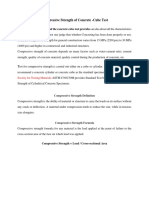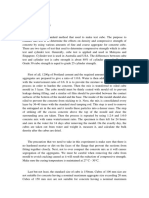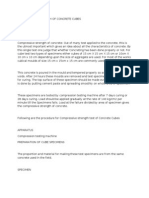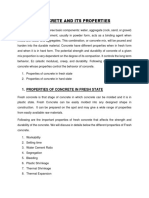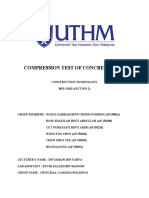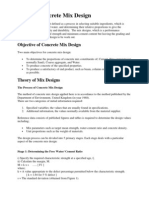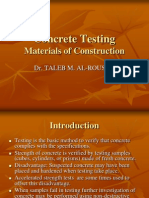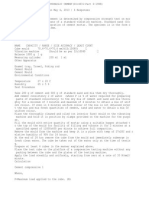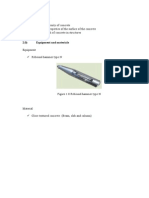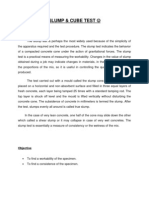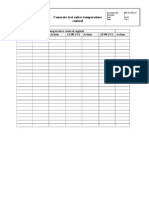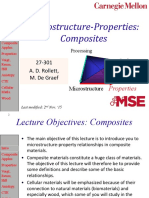Professional Documents
Culture Documents
Concrete Test Cube Procedure
Uploaded by
EE007CACopyright
Available Formats
Share this document
Did you find this document useful?
Is this content inappropriate?
Report this DocumentCopyright:
Available Formats
Concrete Test Cube Procedure
Uploaded by
EE007CACopyright:
Available Formats
Concrete Test Cube Procedure
Concrete's compressive-strength mostly depends on the mix design. But it is affected by several other
factors like mixing of concrete, placing of concrete, curing of concrete as well as quality of concrete
ingredients. So we can't be assured that if we produce concrete as per mix-design we will get desired
compressive strength. However, we should know the concrete compressive strength for every part of a
concrete-structure.
For knowing the compressive-strength of concrete, we generally test a concrete-cube or concrete-
cylinder at a laboratory. These cubes/cylinders are made on the construction site.
Apparatus:
Slump cone
Spirit level
Measuring tape
Cube Mould (150x150x150 mm)
Tamping bar
Steel Float/Trowel
Procedure of Making Concrete:
For the purpose of this test a mix ratio of 2,5 : 4 : 7 were used and the test cube mould was used as
measuring instrument. Due to the quantity required the ingredients were halved.
Place fine aggregate and cement into mixer and mix thoroughly
Add coarse aggregate and mix until evenly distributed
Add water and mix until the mixture is consistent.
If you are happy with your mixture proceed to do a slump test to ensure that the water added is not too
much but just sufficient.
Ensure that your cone and base are clean. Add scoops of your concrete to the cone in layers of
approximately 50mm and compact each layer with the tamping bar.
The top of the cone is finished of using a trowel and the cone is removed. The height difference between
the concrete and the actual cone is measured and this indicates the water content.
Very dry mixes; having slump 0 25 mm are used in road making, low workability mixes; having slump
10 40 mm are used for foundations with light reinforcement, medium workability mixes; 50 - 90 for
normal reinforced concrete placed with vibration, high workability concrete; > 100 mm.
Procedure of Making Concrete test Cube:
Making concrete-cube specimen is simple and it is done in three simple steps.
1. Cleaning & Fixing mould,
2. Placing, Compacting & Finishing concrete, and
3. Curing
1. Cleaning & Fixing mould
Clean the cube-mould properly and apply oil on inner surface of mould. But no oil should be visible on
the surface. Fix the cube mould with base plate tightly. No gap should be left in joints so that cement-
slurry doesn't penetrate. Place the mould on levelled surface.
2. Placing, Compacting & Finishing concrete
Place concrete into mould in three layers. Compact each layer by giving blows with the tamping bar.
Remove excess concrete from the top of mould and finish concrete surface with trowel. Make the top
surface of concrete cube even and smooth.
Leave the mould completely undisturbed for first four hours after casting. After ending undisturbed
period, put down casting date and item name on the top of concrete specimen with a permanent
marker or engraver.
3. Curing
Remove the cube specimens from the mould after 24 hours of casting. For removing specimen from
mould, first loosen all nut-bolts and carefully remove specimen because concrete is still weak and can be
broken. Immediately after removing, put the specimen into a tank of clean water for curing. Make sure
cube specimen is fully submerged in water.
After 7/28 days of curing, take out the specimens from water tank and send to laboratory for testing.
Generally three cube specimens are tested separately at a laboratory and the average result is counted
as concrete compressive-strength. In the case of this test only four specimens were made to be tested
as a pair on days 7 and 28.
Compressive strength of different grades of concrete at 7 and 28 days
Grade of
Concrete
Minimum compressive
strength N/mm
2
at 7 days
Specified characteristic compressive
strength (N/mm
2
) at 28 days
M15 10 15
M20 13.5 20
M25 17 25
M30 20 30
M35 23.5 35
M40 27 40
M45 30 45
You might also like
- Compressive Strength of ConcreteDocument9 pagesCompressive Strength of ConcreteAmos kiprutoNo ratings yet
- Compressive Strength of Concrete - Cube Test, Procedure, Apparatus & ResultsDocument30 pagesCompressive Strength of Concrete - Cube Test, Procedure, Apparatus & ResultsAnonymous Qm0zbNkNo ratings yet
- Cube and Slump Test ReportDocument13 pagesCube and Slump Test ReportZahir Solihin97% (29)
- Errors of Observation in Concrete Testing LabsDocument30 pagesErrors of Observation in Concrete Testing LabsSuryasis Dasgupta25% (4)
- Cube TestDocument11 pagesCube TestKe Sing100% (2)
- Strength Test On ConcreteDocument23 pagesStrength Test On ConcreteMukesh Kumar SamotaNo ratings yet
- Cube Test ReportDocument2 pagesCube Test ReportyapluyiNo ratings yet
- Slump Test REPORTDocument5 pagesSlump Test REPORTLove Rosiee100% (1)
- Cube Test ReportDocument9 pagesCube Test ReportAnabarat Prem67% (6)
- Testing of Concrete CubeDocument5 pagesTesting of Concrete CubeVinod NairNo ratings yet
- Slump Test ReportDocument4 pagesSlump Test ReportAzman ScxNo ratings yet
- Compressive Strength of ConcreteDocument3 pagesCompressive Strength of ConcreteNitisha Rathore100% (3)
- Compressive Strength Test ProcedureDocument9 pagesCompressive Strength Test ProcedureAnique Ur RehmanNo ratings yet
- REPORT Slump TestDocument6 pagesREPORT Slump TestFatin Khairunnisa79% (19)
- Concrete Lab ReportDocument8 pagesConcrete Lab ReportJun Kang100% (2)
- Strength of Concrete Cubes and CylindersDocument6 pagesStrength of Concrete Cubes and CylindersZiyad12100% (2)
- Objective of Concrete Mix DesignDocument11 pagesObjective of Concrete Mix DesignJude Prasanna0% (1)
- Slump TestDocument18 pagesSlump Testmustakim_sedek83% (36)
- Civil Lab Test 1Document4 pagesCivil Lab Test 1Kalomenni90% (10)
- Concrete Lab ReportDocument10 pagesConcrete Lab ReportMadalin-Cristian SalcianuNo ratings yet
- Concrete Cube TestDocument6 pagesConcrete Cube TestMd. Mynul HossainNo ratings yet
- Concrete Mixing and Testing Lab ReportDocument8 pagesConcrete Mixing and Testing Lab ReportSoundMan56100% (4)
- Compressive Strength Test On Concrete CylindersDocument10 pagesCompressive Strength Test On Concrete CylindersHaydar Taş60% (5)
- Conrete Mix LabDocument22 pagesConrete Mix LabTarek Cheaib100% (4)
- Discussions Design Mix Concrete (Slump, Compacting, Design Form)Document6 pagesDiscussions Design Mix Concrete (Slump, Compacting, Design Form)Salmah AbasNo ratings yet
- Properties of Fresh and Hard ConcreteDocument13 pagesProperties of Fresh and Hard Concretemudasir afzal100% (1)
- Hardened Concrete and Methods of TestingDocument27 pagesHardened Concrete and Methods of TestingShepherd NhangaNo ratings yet
- Concrete Slump TestDocument5 pagesConcrete Slump TestPriyanka Mishra100% (1)
- Test Prcedure For ConcreteDocument57 pagesTest Prcedure For Concreteneroshan1978100% (2)
- Cube Test PDFDocument6 pagesCube Test PDFSaaidh100% (2)
- Concrete Full ReportDocument54 pagesConcrete Full ReportLingChiann玲倩100% (1)
- Initial and Final Setting Time of CementDocument2 pagesInitial and Final Setting Time of CementMastani Bajirao100% (1)
- Bs Mix Design Doe MethodDocument22 pagesBs Mix Design Doe Methodsanthu25693% (27)
- Lab Sheet - Atterberg LimitsDocument6 pagesLab Sheet - Atterberg LimitsLuqman YusofNo ratings yet
- Concrete Slump TestDocument3 pagesConcrete Slump TestShaan LalwaniNo ratings yet
- C3 Fresh and Hardened Concrete TestDocument11 pagesC3 Fresh and Hardened Concrete TestSyukri Abd KadirNo ratings yet
- Compressive and Tensile Strength of Cement MortarDocument4 pagesCompressive and Tensile Strength of Cement MortarRadha KrishnanNo ratings yet
- Compression Test of Concrete CubeDocument10 pagesCompression Test of Concrete CubeRose Shazilah100% (2)
- Compressive Strength of Mortar Cubes AssignmentDocument11 pagesCompressive Strength of Mortar Cubes AssignmentPablo Gomes80% (5)
- Lab Report 1 DETERMINATION OF AGGREGATE IMPACT VALUE (AIV) (BS 812-112)Document3 pagesLab Report 1 DETERMINATION OF AGGREGATE IMPACT VALUE (AIV) (BS 812-112)Kashif IqbaljNo ratings yet
- Compression Strength Test Data SheetDocument1 pageCompression Strength Test Data SheetDileepa Dissanayake100% (2)
- Rebound HammerDocument6 pagesRebound Hammerahmadfarriz100% (1)
- Concrete Mix Design StepsDocument11 pagesConcrete Mix Design StepsMuhammad Mahamudul Hasan94% (17)
- CBR TestDocument4 pagesCBR TestAtish Kumar100% (1)
- Manual Concrete PDFDocument48 pagesManual Concrete PDFHamza HussainNo ratings yet
- Concrete Lab ReportDocument14 pagesConcrete Lab ReportRahma HusseinNo ratings yet
- Concrete Testing-11Document32 pagesConcrete Testing-11kamal hameed tayy75% (8)
- Highway Lab ReportDocument9 pagesHighway Lab Reportcarlton0878% (9)
- Compressive Strength of Hydraulic CementDocument3 pagesCompressive Strength of Hydraulic CementEr Mansoor HussainNo ratings yet
- CONCLUSION Bitumen TestDocument1 pageCONCLUSION Bitumen TestFirash Imran100% (1)
- Standard Consistency of Cement - Lab ReportDocument3 pagesStandard Consistency of Cement - Lab Reportgarima33% (3)
- Rebound HammerDocument5 pagesRebound HammerNSBMRNo ratings yet
- 3.4. Molding, Compaction and Curing of ConcreteDocument7 pages3.4. Molding, Compaction and Curing of ConcreteThant ZinNo ratings yet
- Cylinder Mould (100mm X 200mm or 150mm X 300mm or 300mm X 600mm) Bulled-Nosed Rod (16mm Diam. & 600mm Long) Steel FloatDocument3 pagesCylinder Mould (100mm X 200mm or 150mm X 300mm or 300mm X 600mm) Bulled-Nosed Rod (16mm Diam. & 600mm Long) Steel FloatStain HecNo ratings yet
- TestDocument23 pagesTestAGunaSekaranNo ratings yet
- A Simple Guide To Concrete Cube TestingDocument7 pagesA Simple Guide To Concrete Cube TestingJaneshaNo ratings yet
- A Report On Workability of Fresh Concrete by Slump TestDocument5 pagesA Report On Workability of Fresh Concrete by Slump TestRishabhJain100% (1)
- CongretetestingDocument11 pagesCongretetestingBatepola BacNo ratings yet
- Slump Test Report PMMDocument7 pagesSlump Test Report PMMLuqman Yusof83% (12)
- Compressive Strength of Concrete - Cube Test Procedure ResultsDocument5 pagesCompressive Strength of Concrete - Cube Test Procedure ResultsAriyan AriyanNo ratings yet
- Power Systems: Concrete Test Cubes Temperature ControlDocument1 pagePower Systems: Concrete Test Cubes Temperature ControlEE007CANo ratings yet
- Rain Logbook: Date Star T Tim e End Tim e Amou NT Tim e Dela y Damage Severity Projected Repair Delay (H) HVT Supervis orDocument1 pageRain Logbook: Date Star T Tim e End Tim e Amou NT Tim e Dela y Damage Severity Projected Repair Delay (H) HVT Supervis orEE007CANo ratings yet
- Concrete Test Cubes WIDocument2 pagesConcrete Test Cubes WIEE007CANo ratings yet
- High Voltage Technology: Concrete Cube Test RegisterDocument1 pageHigh Voltage Technology: Concrete Cube Test RegisterEE007CANo ratings yet
- Heavy MetalsDocument841 pagesHeavy MetalsAnonymous EzNMLt0K4CNo ratings yet
- Tunneling Current Through A Possible All-Perovskite Oxide P-N JunctionDocument4 pagesTunneling Current Through A Possible All-Perovskite Oxide P-N Junctionचन्द्रभाल सिंहNo ratings yet
- Session 9.1 - Compaction PDFDocument10 pagesSession 9.1 - Compaction PDFmohamedyahaiNo ratings yet
- Effect of PH On GFP DenaturationDocument10 pagesEffect of PH On GFP DenaturationDominic YapNo ratings yet
- Babu Banarasi Das: Practice QuestionsDocument7 pagesBabu Banarasi Das: Practice QuestionsNeeraj KshatriyaNo ratings yet
- Bio Pure Ken Sigma 3Document6 pagesBio Pure Ken Sigma 3Faarhad Masraf Abdul HamidNo ratings yet
- 2.5.4 Soil CollapseDocument3 pages2.5.4 Soil Collapsecandice2811No ratings yet
- A Review On Green Hydrogen Future of Green Hydrogen in IndiaDocument7 pagesA Review On Green Hydrogen Future of Green Hydrogen in IndiaSPE Baghdad sectionNo ratings yet
- Advanced Materials, Robotics and NanotechnologyDocument43 pagesAdvanced Materials, Robotics and NanotechnologyIsabella MagallanesNo ratings yet
- 44th International Chemistry Olympiad Preparatory Problems SolutionsDocument130 pages44th International Chemistry Olympiad Preparatory Problems SolutionsIsabelle YangNo ratings yet
- UOP Platforming ProcessDocument32 pagesUOP Platforming ProcessTanveer Ahmad80% (5)
- Topic 4.3 - Covalent Structures Short Answer Questions 2Document37 pagesTopic 4.3 - Covalent Structures Short Answer Questions 2Donal GrayNo ratings yet
- Synthesis and Characterizations of Hydroxyapatite Derived Blood Clam Shells (Anadara Granosa) and Its Potency To Dental RemineralizationsDocument12 pagesSynthesis and Characterizations of Hydroxyapatite Derived Blood Clam Shells (Anadara Granosa) and Its Potency To Dental RemineralizationsThuầnNo ratings yet
- Journal of Food Engineering: Jir Í Blahovec, Stavros YanniotisDocument6 pagesJournal of Food Engineering: Jir Í Blahovec, Stavros YanniotisKarina N. Catalán SandovalNo ratings yet
- Sika User Manual Pro RetailDocument20 pagesSika User Manual Pro RetailSeno HadiyantoNo ratings yet
- Assessment Test in Science Module 2Document2 pagesAssessment Test in Science Module 2Caren Mae PunzalanNo ratings yet
- Archroma - Passion For PrintingDocument10 pagesArchroma - Passion For PrintingNguyễn Huy Cường100% (1)
- HND Sector 2 Vol3-1Document530 pagesHND Sector 2 Vol3-1mbabit leslieNo ratings yet
- 1 FFFFDocument8 pages1 FFFFfaguilarNo ratings yet
- Lithosphere and Soil PollutionDocument102 pagesLithosphere and Soil PollutionPranav MittalNo ratings yet
- Aci 318-02Document3 pagesAci 318-02Fiorella CondorNo ratings yet
- Name: Grade 12 - AMETHYST Date: April 23, 2021 1 Summative Exam - Physical Science (Quarter 3)Document1 pageName: Grade 12 - AMETHYST Date: April 23, 2021 1 Summative Exam - Physical Science (Quarter 3)Jeff Tristan CaliganNo ratings yet
- Biology Paper 1Document32 pagesBiology Paper 1Cameron DaviesNo ratings yet
- L5 Composites Part 1and2 23sep15Document117 pagesL5 Composites Part 1and2 23sep15Tayyab AttariNo ratings yet
- Journal Summary Phy592Document3 pagesJournal Summary Phy592Fatin Nur Syahirah AzharNo ratings yet
- Informacion Del MonoetilenglicolDocument14 pagesInformacion Del MonoetilenglicolMartin Oscar Pacheco AlvarezNo ratings yet
- AFM PresentationDocument16 pagesAFM PresentationSulficker AliNo ratings yet
- C-E Minerals: MSDS For Mulcoa 60/mulgrain 60/mulblast 60: Revision Date: 01/23/2013 Page 1 of 7Document7 pagesC-E Minerals: MSDS For Mulcoa 60/mulgrain 60/mulblast 60: Revision Date: 01/23/2013 Page 1 of 7Muniruddin AmranNo ratings yet
- Inter 2 Physics Solved Mcqs Battle of Brains by Ambitious AcademyDocument7 pagesInter 2 Physics Solved Mcqs Battle of Brains by Ambitious AcademySaad WaseemNo ratings yet
- Hydrogen 14 Session 19 - MNMDocument95 pagesHydrogen 14 Session 19 - MNMChakravarthy BharathNo ratings yet
